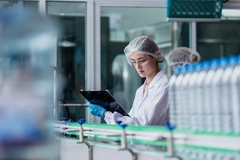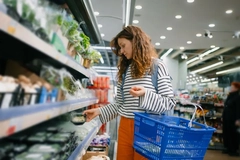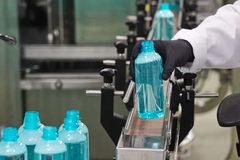LG Electronics: E-waste packaging management efforts continue with Consumer Technology Circularity Initiative
05 Feb 2024 --- LG Electronics US senior vice president John I. Taylor speaks to Packaging Insights about the company’s recent founding membership of the Consumer Technology Circularity Initiative (CTCI) and its implications for the future of electronics packaging.
Launched at the Consumer Electronic Show 2024 in Las Vegas, US, by the Consumer Technology Association, the initiative is a voluntary industry program to highlight industry innovations across the lifecycle of consumer technology products that reduce waste, stimulate reuse, enhance recycling, reduce climate impact and result in less disposal of consumer electronics.
We also discuss the company’s packaging strategies, which involve advancing a circular economy through the use of recycled plastics, seeking to mitigate environmental impacts with a goal of 95% waste recycling and offering solutions like a take-back program to enhance consumer experience.
As a founding member of the CTCI, how does LG envision the industry-wide impact of this initiative?
Taylor: This voluntary industry lifecycle initiative can make a significant impact on reducing waste, stimulating more reuse, enhancing recycling and reducing climate impact. As a CTCI founding member, LG Electronics is advancing a circular economy, seeking to mitigate the environmental effects and offering solutions that enhance the consumer experience to live sustainability. The Consumer Technology Circularity Initiative was announced at CES 2024.
The Consumer Technology Circularity Initiative was announced at CES 2024.
LG is expanding the use of recycled plastics in product raw materials and developing cushioning materials containing 50% waste polystyrene in packaging. What are the associated pros and cons?
Taylor: We have the technology to produce recycled expanded polystyrene with high post-consumer content to create recycled buffers for eco-friendly packaging. If packaging materials with a high recycled content work, they will naturally have environmental effects such as reducing waste and carbon emissions. There are issues with the high unit price of recycled materials and the stable supply of waste materials. Still, we’re working with various partners to address these challenges and plan to apply more high-quality recycled materials to our products and packaging.
We’re using recycled plastics in 19 product categories of home appliances and consumer electronics, such as air cleaners, refrigerators and sound bars. This is just one element of our broader circular economy strategy that also encompasses reducing materials usage and designing for recyclability.
LG offers a packaging take-back program. How does this program operate?
Taylor: LG Electronics’ product packaging recycling is a system where the installer collects the packaging after setting up the product, and if the customer installs the product themself, it is recommended to recycle it according to local regulations. We are designing packaging to produce less waste and working to improve recycling further through dynamic materials management.
What are the biggest challenges the electronics industry faces in moving toward a circular economy?
Taylor: One such challenge is designing for recyclability. Some electronic products with complex and integrated components can be challenging to disassemble and recover materials during recycling. Designing products for disassembly and reuse is not always a straightforward task.
At LG Electronics, we make products that take into account resource circulation from the product planning level. The electronics industry relies on a global supply chain, which can complicate efforts to establish consistent and efficient recycling systems. This is why it’s important to have coordination and collaboration among various stakeholders across different regions.
How does LG Electronics plan to achieve its goal of a 95% waste recycling rate at production sites by 2030?
Taylor: To recycle over 95% of the waste at our business sites worldwide, LG Electronics is reducing overall waste generation, including optimizing production processes to minimize material waste and promoting more eco-friendly materials. We seek out and contract with companies that can recycle the waste we generate to help ensure that the trash is recycled properly and responsibly. We’re also expanding ZWTL certification for our global operations, starting with South Korea.  LG is expanding the use of recycled plastics in product raw materials and developing cushioning materials containing 50% waste polystyrene in packaging.
LG is expanding the use of recycled plastics in product raw materials and developing cushioning materials containing 50% waste polystyrene in packaging.
How does LG’s closed-loop recycling process work, and what steps are taken to reapply waste from recycled products into new products?
Taylor: The LG Electronics recycling cycle system uses a proven multi-step process. In South Korea, for example, used electronics are collected at local logistics centers and transported to recycling centers. There, components of the used appliances are dismantled and shredded into uniform sizes. From the dismantled and shredded appliances, recyclable materials are selected. Certain materials are further processed into recycled raw materials. These raw materials are then used to make new products. Closed-loop recycling often involves multiple stakeholders, including suppliers, manufacturers and waste management companies.
How is LG’s target to use a cumulative 600,000 tons of recycled plastics from 2021 to 2030 progressing?
Taylor: We’re incorporating recycled plastic into more and more products as we drive toward our cumulative goal of 600,000 tons by 2030. To date, we have used a cumulative 112,230 tons. Customizing recycled plastics to a product is necessary because different parts have different properties or characteristics that require various plastics to be used. We are developing the technology so that as many recycled plastics as possible can be used without any issues with product performance.
How does LG make recycling outdated electronic products convenient for consumers?
Taylor: With regulations varying by state, community collaboration is needed to help consumers recycle efficiently. In South Korea, consumers can return used electronics to specific locations (stores, ward offices, etc.), and campaigns to encourage recycling are also underway. Our employees also visit schools to educate students about resource recycling, and we are working with local governments to establish a closed loop for electronics.
Similarly, we have a robust e-waste program in the US to help consumers responsibly recycle unused and unwanted electronic products. LG has made the process cost-effective (free-of-charge in most states), convenient and straightforward. Around the world, we provide consumers with transparent information about the recycling process, including how materials are recovered and the environmental benefits.
By Radhika Sikaria












